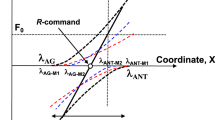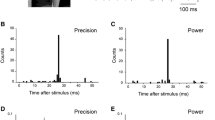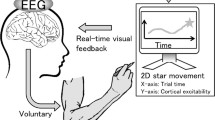Abstract
The objective of this study was to examine phase- and task-dependent modulation of stretch reflexes during repetitive finger movements in writer’s cramp, and compare them with normal controls from our previous study. A subject with writer’s cramp conducted two rhythmic tasks, index finger abduction (RFA) and a pen-squeezing (RPS) task akin to handwriting. Stretch reflexes were evoked by mechanical perturbations at random phases of each task. Surface electromyograms (EMG) were recorded from two hand muscles, first dorsal interosseous (FDI) and flexor digitorum superficialis (FDS). The reflex response and background EMG activity of each muscle were modulated in a phase-dependent manner in both tasks. However, they varied largely in phase during the RFA task, but in approximately inverse phase-relationship during RPS. Reflex sensitivity, as represented by the slope of the linear regression between response and background, was much lower for both muscles in the ‘writing’ task (RPS) than in the RFA task with its positively correlated responses. These phase- and task-related modulation patterns differed dramatically from those observed in our control subjects, where reflex responses were modulated largely in phase with background activity and reflex sensitivity was much higher, particularly in FDI during RFA and FDS during RPS. The altered reflex modulation patterns in writer’s cramp may reflect deficiencies of integration of proprioceptive afferent inputs and reduced inhibition at cortical and spinal levels during writing performance. Results from this case study support clinically identified task-specific feature of focal hand dystonia.


Similar content being viewed by others
References
Berardelli A, Rothwell JC, Hallett M, Thompson PD, Manfredi M, Marsden CD (1998) The pathophysiology of primary dystonia. Brain 121:1195–1212
Bhatia KP, Marsden CD (1994) The behavioural and motor consequences of focal lesions of the basal ganglia in man. Brain 117:859–876
Bütefisch CM, Boroojerdi B, Chen R, Battaglia F, Hallett M (2005) Task-dependent intracortical inhibition is impaired in focal hand dystonia. Mov Disord 20:545–551
Chen R, Hallett M (1998) Focal dystonia and repetitive motion disorders. Clin Orthop Relat Res 351:102–106
Chen RS, Tsai CH, Lu CS (1995) Reciprocal inhibition in writer’s cramp. Mov Disord 10:556–561
Chen R, Wassermann EM, Canos M, Hallett M (1997) Impaired inhibition in writer’s cramp during voluntary muscle activation. Neurology 49:1054–1059
Dietz V (2002) Do human bipeds use quadrupedal coordination? Trends Neurosci 25:462–467
Filipovic SR, Ljubisavljevic M, Svetel M, Milanovic S, Kacar A, Kostic VS (1997) Impairment of cortical inhibition in writer’s cramp as revealed by changes in electromyographic silent period after transcranial magnetic stimulation. Neurosci Lett 222:167–170
Hallett M (1998a) The neurophysiology of dystonia. Arch Neurol 55:601–603
Hallett M (1998b) Physiology of dystonia. Advances in Neurology. In: Fahn S, Marsden CD, DeLong M (eds) Dystonia 3, vol 78. Lippincott-Raven, Philadelphia, pp 11–18
Kaji R, Rothwell JC, Katayama M, Ikeda T, Kubori T, Kohara N, Mezaki T, Shibasaki H, Kimura J (1995) Tonic vibration reflex and muscle afferent block in writer’s cramp. Ann Neurol 38:155–162
Koelman JH, Willemse RB, Bour LJ, Hilgevoord AA, Speelman JD, Ongerboer de Visser BW (1995) Soleus H-reflex tests in dystonia. Mov Disord 10:44–50
McCrea DA (2001) Spinal circuitry of sensorimotor control of locomotion. J Physiol 533:41–50
Nakashima K, Rothwell JC, Day BL, Thompson PD, Shannon K, Marsden CD (1989) Reciprocal inhibition between forearm muscles in patients with writer’s cramp and other occupational cramps, symptomatic hemidystonia and hemiparesis due to stroke. Brain 112: 681–697
Naumann M, Reiners K (1997) Long-latency reflexes of hand muscles in idiopathic focal dystonia and their modification by botulinum toxin. Brain 120:409–416
Odergren T, Iwasaki N, Borg J, Forssberg H (1996) Impaired sensory-motor integration during grasping in writer’s cramp. Brain 119:569–583
Panizza ME, Hallett M, Nilsson J (1989) Reciprocal inhibition in patients with hand cramps. Neurology 39:85–89
Perneger TV (1998) What’s wrong with Bonferroni adjustments? Br Med J 316:1236–1238
Quartarone A, Girlanda P, Risitano G, Picciolo G, Sinicropi S, Nicolosi C, Macaione V, Messina C (1998) Focal hand dystonia in a patient with thoracic outlet syndrome. J Neurol Neurosurg Psychiatry 65:272–274
Ridding MC, Sheean G, Rothwell JC, Inzelberg R, Kujirai T (1995) Changes in the balance between motor cortical excitation and inhibition in focal, task specific dystonia. J Neurol Neurosurg Psychiatry 59:493–498
Sheehy MP, Marsden CD (1982) Writers’ cramp. A focal dystonia. Brain 105:461–480
Xia R, Bush BMH, Karst GM (2005) Phase-dependent and task-dependent modulation of stretch reflexes during rhythmical hand tasks in humans. J Physiol 564:941–951
Zehr EP, Collins DF, Frigon A, Hoogenboom N (2003) Neural control of rhythmic human arm movement: phase dependence and task modulation of hoffmann reflexes in forearm muscles. J Neurophysiol 89:12–21
Acknowledgments
The awards to Ruiping Xia of a Scholarship by the Committee of Vice-Chancellors and Principals of the Universities of the UK, and of a University of Bristol Postgraduate Fellowship, are gratefully acknowledged. We thank Tony Macdonald in the Physiology Department, University of Bristol, UK, for technical assistance in building some of the equipment.
Author information
Authors and Affiliations
Corresponding author
Rights and permissions
About this article
Cite this article
Xia, R., Bush, B.M.H. Modulation of reflex responses in hand muscles during rhythmical finger tasks in a subject with writer’s cramp. Exp Brain Res 177, 573–578 (2007). https://doi.org/10.1007/s00221-007-0880-9
Received:
Accepted:
Published:
Issue Date:
DOI: https://doi.org/10.1007/s00221-007-0880-9




